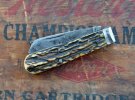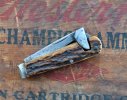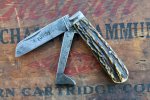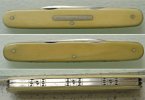I can see that when it's more than a single blade but how would have worked with single blade folders of the same period? with the JR&S on the body of the blade and the No 6 Norfolk Street, Sheffield, England or there abouts on the same side at the tang and the star and cross on the back of the tang where would the 'Cutlers to' have been stamped?
Despite the importance Rodgers placed on their Royal Warrants, and despite their very frequent use of blade stamps, they don't seem to have used it a great deal on single-blade folders. Since the majority of their knives were always made by Little Mesters and outworkers, perhaps they didn't want all those Royal stamps floating about Sheffield



Added to the sheepsfoot jack collection with a Thomas Turner & Co stag Encore stamped. Has a timber scribe secondary, you don't find these 2 blades all that often.
View attachment 1648166View attachment 1648167View attachment 1648168View attachment 1648169
A nice addition my friend


Thanks Ed, as far as I know the timber scribe was used for marking anything wood, timber, shipping boxes, etc.
As you say, scribes had an important function in terms of marking timber, barrels, wooden crates, etc. However, in 1699, following a petition from ship-owners and merchants two years earlier, and a decade of prior agitation, the passage of the Bulk Tobacco Act by the British Parliament, stopped tobacco being shipped in anything other than wooden 'cask, chest, or case each containing two hundredweight of neat Tobacco'. This was not only to prevent damage caused by climatic conditions and poor storage, but had the aim of preventing endemic pilferage ('sweepings'), which was regarded as a right and wage-supplement by everyone from the lowliest seaman and dockers, to the highest-ranking officers. Huge hogsheads became the primary shipping container, and as well as protecting the tobacco merchants goods, and ensuring the Crown received its full revenue, reduced unloading times were also central to the scheme, with labour costs, and the numbers of dockers needed to be employed, being reduced in turn. The cooper thus became a more important figure, and the timber scribe an essential tool, and of course it wasn't just tobacco that was shipped in hogsheads, vast amounts of sugar, alcohol, and all sorts of other goods, were shipped in this way. Pilferage of goods continued, but could only be carried out with the assistance of the cooper and his tools. As Peter Lindbaugh describes in
The London Hanged, "They were the most craft-conscious workers of the river, whose hand skills gave them an authority among the river trades lasting into the twentieth century." Lindbaugh goes on to describe how the coopers 'lorded about' with their 'scribing irons'. By 1796, the powerful London coopers were lawfully permitted a 'sampling allowance' of 26lbs per hogshead, in addition to their wages. Since the shipping of freight did not just take place between America and Great Britain, and goods were often moved in barrels and wooden crates between every town and village, it's not hard to see how a method of marking ownership, and the security of sealed bungs and closures, would be an important function, requiring a special tool, and the skill to use it. The same can be said, of course, of every tree felled, and every plank of wood made from it.






















